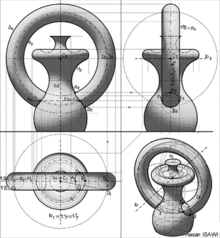This article has multiple issues. Please help improve it or discuss these issues on the talk page. (Learn how and when to remove these messages)
|

Descriptive geometry is the branch of geometry which allows the representation of three-dimensional objects in two dimensions by using a specific set of procedures. The resulting techniques are important for engineering, architecture, design and in art.[1] The theoretical basis for descriptive geometry is provided by planar geometric projections. The earliest known publication on the technique was "Underweysung der Messung mit dem Zirckel und Richtscheyt" (Observation of the measurement with the compass and spirit level), published in Linien, Nuremberg: 1525, by Albrecht Dürer. Italian architect Guarino Guarini was also a pioneer of projective and descriptive geometry, as is clear from his Placita Philosophica (1665), Euclides Adauctus (1671) and Architettura Civile (1686—not published until 1737), anticipating the work of Gaspard Monge (1746–1818), who is usually credited with the invention of descriptive geometry.[2][3] Gaspard Monge is usually considered the "father of descriptive geometry" due to his developments in geometric problem solving. His first discoveries were in 1765 while he was working as a draftsman for military fortifications, although his findings were published later on.[4]
Monge's protocols allow an imaginary object to be drawn in such a way that it may be modeled in three dimensions. All geometric aspects of the imaginary object are accounted for in true size/to-scale and shape, and can be imaged as seen from any position in space. All images are represented on a two-dimensional surface.
Descriptive geometry uses the image-creating technique of imaginary, parallel projectors emanating from an imaginary object and intersecting an imaginary plane of projection at right angles. The cumulative points of intersections create the desired image.
- ^ Joseph Malkevitch (April 2003), "Mathematics and Art", Feature Column Archive, American Mathematical Society
- ^ James Stevens Curl, ed. (2015). "Guarini, Guarino". A Dictionary of Architecture. Oxford University Press. p. 337. ISBN 9780198606789.
- ^ Bianchini, Carlo (2012). "Stereotomy Role in Guarino Guarini's Space Research". Nuts and Bolts of Construction History. 1: 257–263. ISBN 978-2-7084-0929-3.
- ^ Ingrid Carlbom, Joseph Paciorek (December 1978), "Planar Geometric Projections and Viewing Transformations", ACM Computing Surveys, 10 (4): 465–502, CiteSeerX 10.1.1.532.4774, doi:10.1145/356744.356750, S2CID 708008



